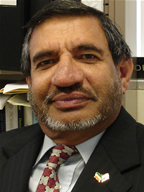Second Edition Released
Book Is Aimed at Improving the Safety of Navigation by Improving Data
April 2, 2007
By Russ Hudson
Mohinder Grewal, professor of electrical engineering, has no problems finding his way around global navigation satellite or inertial navigation systems. He recently saw the second edition of his book, “Global Positioning Systems, Inertial Navigation and Integration,” published by Wiley & Sons.
The book was co-authored by Lawrence R. Weill, CSUF emeritus professor of mathematics, and Angus P. Andrews, retired senior scientist for Rockwell.
Written as a guide to global navigation satellite and inertial navigation systems, the book offers solutions to real-world problems, primarily by using Kalman filtering — a method to alleviate interference in order to accurately track a moving object — and MATLAB — a high-level computer language that can perform computationally intensive tasks.
“GPS is used in everyday life,” Grewal pointed out. “In cell phones, automobiles, geo-caching, hiking — even golf — as well as in commercial aircraft and national security. This book addresses applications and integrity issues that are critical to our safety and well-being.
“For engineers in all fields, for those in computer science, and for management of navigation with GPS and inertial navigation systems, this book offers a systematic approach,” added Grewal. “Because of that, this is also a text book on the subject.”
Because GPS is a fast-changing field, the professor said, the second edition was produced to include cutting-edge technology developed since the first edition.
Among the new technology included in the book is the Wide Area Augmentation System, used to improve aviation navigation safety by assisting light-aircraft pilots to locate airports in bad weather conditions. The system — first approved by the Federal Aviation Administration in 2003 — works with two dozen GPS satellites orbiting Earth.
Grewal, a member of the campus faculty since 1975, has taught GPS for more than 10 years.
Another of Grewal’s books “Kalman Filtering: Theory & Practice Using MATLAB” was first published in 1993 with its second edition in 2001, also by John Wiley & Sons. Grewal is working on the third edition of that book, with an early-2008 release date anticipated. Kalman filtering is a mathematical algorithm that is an integral part of GPS technology, Grewal pointed out, so the two books are complementary.
GPS, Time and Atomic Clocks |
| Lecture Set for April 27 “GPS, Time and Atomic Clocks” Bernardo Jaduszilwer, principal director of Aerospace Corp.’s Electronics and Photonics Laboratory, will explain Global Navigation Satellite Systems, such as those used by the U.S.’s Global Positioning System, Russia’s GLONASS and the European Union’s Galileo, at 1 p.m. on April 27 in Room 121 of McCarthy Hall. Jaduszilwer will address the heart of the positioning systems, the atomic clock, including how it performs and its physical principles. He then will address specific clock technologies used in current GNSS and expected to be in near-future GNSS. “GPS, Time and Atomic Clocks” is sponsored by the Physics Department. For more information, call 278-3366. |


 Produced by the Office of Public Affairs at California State University, Fullerton.
Produced by the Office of Public Affairs at California State University, Fullerton.